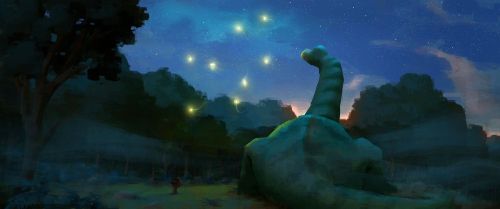 I wanted to discuss this film as part of my investigation into environmental storytelling as it is a good recent example of the animations that are coming out currently as well as I recently watched it for the firs time and really enjoyed it! The film is about what the world would have been like if the meteor that hit Earth had missed and the dinosaurs would have survived to be the more evolved species. This meant that the environments still had to look like Earth but in a way that is still beautiful and untouched by humans. I really liked this aspect of the film as it allowed the environments to be stunning instead of piles of dirt like Wall-E. This animation really raised the bar for a natural-looking world that looked realistic and flawless, the Pixar team used USGS data to build up their terrains and even satellite footage to build the clouds in the sky. I think that by doing this the film looks amazing and hyper-realistic, which is very impressive for an animation to achieve this effect.
I wanted to discuss this film as part of my investigation into environmental storytelling as it is a good recent example of the animations that are coming out currently as well as I recently watched it for the firs time and really enjoyed it! The film is about what the world would have been like if the meteor that hit Earth had missed and the dinosaurs would have survived to be the more evolved species. This meant that the environments still had to look like Earth but in a way that is still beautiful and untouched by humans. I really liked this aspect of the film as it allowed the environments to be stunning instead of piles of dirt like Wall-E. This animation really raised the bar for a natural-looking world that looked realistic and flawless, the Pixar team used USGS data to build up their terrains and even satellite footage to build the clouds in the sky. I think that by doing this the film looks amazing and hyper-realistic, which is very impressive for an animation to achieve this effect.Here is the main setting for the film, 'Clawtooth Mountain' and this is truly a beautiful environment to set an animation almost as if they were trying to get the message across to the audience about how beautiful our planet can be. The production team were heavily inspired by The Grand Tetons, which can be seen below, and as you can see it's almost exactly the same. I have found that with a lot of animations they take heavy inspiration and usually almost replicate environments, this is why it is important for me to learn the skill of being able to go out and record different places that I find interesting.
Something else I found really impressive about this animation was the fact that even though it's a well known fact that water is extremely hard to animate they used the most water shots than any other Pixar film has done before with 125 shots. I felt like this really helped bring the environments together throughout as without the water it wouldn't have felt as natural as it could have with it. All these aspects added together help to bring the environments to life and I loved that they went the extra mile with this film to ensure that happened.

Finally, my favourite environment in this animation was the firefly scene, this one isn't very focuses on the background and more the animating but I still wanted to include it. I loved this scene because it really had a magical feel to it when everything becomes illuminated by the beauty of nature. To make it a little more relevant I have also included some concept art images of how the artists at Pixar imagined it to be, looking at concept art helps me to understand where ideas can come from even in such a simple environment or idea.







































